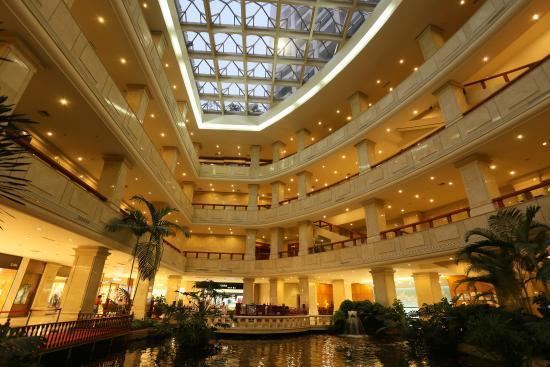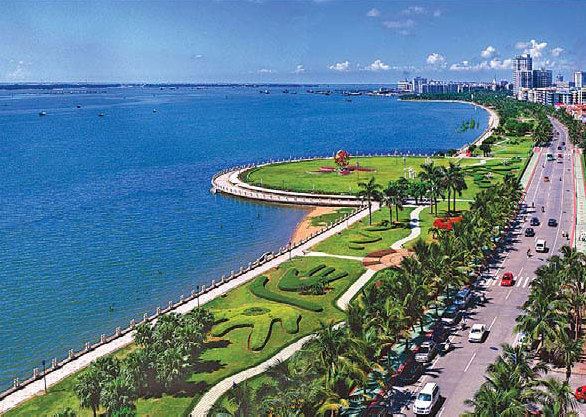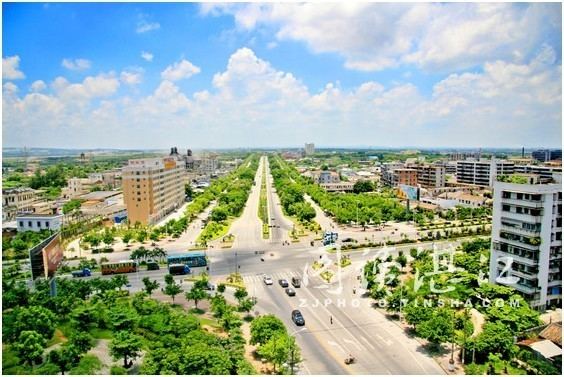Population 1.351 million (2000) CPC Party Chief Liu Xiaohua | Area 12,490 km2 | |
 | ||
Colleges and Universities Guangdong Ocean University, Zhanjiang Normal University, Guangdong Medical College | ||
Country Peoples Republic of China | ||
Map of Zhanjiang
Zhanjiang (Chinese: 湛江; pinyin: Zhànjiāng; Leizhou Min: Tchiàm-kōng), is a prefecture-level city at the southwestern end of Guangdong province, People's Republic of China, facing Hainan to the south.
Contents
- Map of Zhanjiang
- Zhanjiang outset
- Imperial China era
- French colonial period
- PostWorld War II
- Geography
- Climate
- Administration
- Military
- Economy
- Port of Zhanjiang
- Agriculture
- Industry
- Business
- Air
- Rail
- Tourism
- French architectural monuments
- Sports
- References

Its population was 6,994,832 inhabitants at the 2010 census. 1,611,868 live in the built-up area made of four urban districts: Chikan, Xiashan, Potou and Mazhang. In 2007, the city is named China's top ten livable cities by Chinese Cities Brand Value Report, which was released at 2007 Beijing Summit of China Cities Forum.
Zhanjiang outset
Imperial China era

During the Qin Dynasty (221–206 BC), the area belonged to Xiang Shire. The central government of the Han Dynasty (206 BC−220 AD) set Xuwen County administering the whole Leizhou Peninsula. It was one of the earliest departure points on the Marine Silk Road. The population spiked during the Tang (618–907) and Song (960–1279) dynasties. Large numbers of Putian people immigrated to the peninsula during the Song dynasty and soon formed Zhanjiang's linguistic and ethnic majority.
French colonial period

The region was still a small fishing port when it was occupied by the French in 1898. The next year, the French forced the Chinese to lease a small enclave of Zhanjiang to them for 99 years (or until 1997, as the British did in Hong Kong's New Territories) as the territory of Kouang-Tchéou-Wan. The French wanted to develop the port, which they called Fort-Bayard, to serve southern China, in parts where France had exclusive rights to railway and mineral development. Their efforts, however, were hindered by the poverty of the surrounding land. The French retained control of the region until 1943, when the Japanese occupied the area during World War II. At the end of the war, the region returned briefly under French rule before being formally returned to China in 1946 by General Charles de Gaulle, then French head of state.
Post–World War II
Upon receiving the territory from the French, the Republic of China government decided to rename Kouang-Tchéou-Wan. The area was historically under the jurisdiction of Zhanchuan county, with a Zhanchuan customs post on the eastern island of the territory. As "Zhanjiang" was a historical variant of "Zhanjiang", it was decided to name the city "Zhanjiang".
Following the establishment of the People's Republic in 1949, Zhanjiang developed new importance. In 1955 a rail link was built to Litang in Guangxi province, where it joined the Hunan-Guangxi Railway. Since then, Zhanjiang has developed into a major modern port serving southern China, usable by ships of up to 50,000 tons. In 1984 Zhanjiang was designated one of the "open" cities of China, where the central government invited foreign investment; this spurred the city's further industrial development. It has shipyards and engineering works; automobile, electrical-appliance, and textile plants; and sugar refineries, flour and rice mills, and chemical works.
In the early 1990s a new rail line was completed, linking Zhanjiang with Guangzhou, the provincial capital. The line was later extended to Hai'an, at the southernmost tip of Leizhou Peninsula, where trains could be transported by Guangdong–Hainan Ferry (part of the Guangdong–Hainan Railway) across the Hainan Strait to Haikou.
Until the introduction of Pinyin spelling, it was often known in the west as "Tsamkiang", "Chankiang" or "Tsamkong", the last name deriving from the Cantonese pronunciation of the name.
Geography
Zhanjiang is to the southwest of the city of Guangzhou on an inlet of the South China Sea. It is on the eastern coast of the Leizhou Peninsula.
The spoken language in downtown districts is Cantonese, while people in most counties speak the Leizhou dialect which is a dialect of Min Chinese. The dialect in Lianjiang County is Hakka. The time zone for Zhanjiang, as with all locations in the People's Republic of China, is Beijing time (GMT +8).
Climate
Zhanjiang has a humid subtropical climate (Köppen Cwa), with short, mild, overcast winters and long, very hot, humid summers. The monthly daily average temperature in January is 15.9 °C (60.6 °F), and in July is 29.0 °C (84.2 °F). From April to September, rainfall is the heaviest and most frequent. Influenced by the ocean climate, Zhanjiang escapes the heat of the summer and chilliness of the winter.
Administration
Zhanjiang has direct jurisdiction over nine county-level divisions:
Military
Zhanjiang is headquarters of the South Sea Fleet of the People's Liberation Army Navy. It is also home base to two marine brigades.
Economy
Zhanjiang is a port city and trade center with a diversified industrial base, including a shipyard, textile plants, sugar refineries. plants producing automobiles, chemicals and electrical appliances as well as rice mills. From 2012 to 2014,economy of Zhanijang booms into a new level. In 2013, with 92 different key projects, the total investment reaches 306.9 millions. In 2014, the GDP of Zhanjiang was 225.87 billions yuan. The growth of GDP was 10 percent. Industrial enterprises above designated size added value of 73.49 billions yuan. Fixed Investment was 102 billions yuan and the growth was about 30 percent. Also, the total retail sales of consumer goods was 116 million dollars with growth of 13.e percent. The government believes that the GDP of Zhanjiang will be double on 2017 to achieve 400 billion and the speed of GDP growth will stay nearly 12 percent.
Port of Zhanjiang
The Port of Zhanjiang is one of the finest deep water ports in China. In history, it was called by Guangzhouwan . It is the southernmost port on the coast of mainland China and serves as a shipping outlet for much of Southwest China. The port of Zhanjiang, built in 1956, was the first modern port designed and developed after the founding of the People's Republic of China and serves as the headquarters for the People's Liberation Army Navy's South Sea Fleet. The Zhanjiang Port is one of the eight major ports in China, with an annual throughput of more than 2,600 million tons. As a natural port, it has about 60 kilometers depth and three islands outside to support. The port helps people in the provinces in South and West China to go to sea quickly and easily. Also, it allows Zhanjiang to be open to navigation with more than 100 countries nowadays. It is important to the development of steel industry in Zhanjiang.
Agriculture
Sugarcane production was Zhanjiang's most prominent agricultural product in 2007: in 2006 it was 9,135,500 tons and it was 10,000,000 tons in 2007. Akoya cultured pearls, pineapples, bananas, papayas, seafood, farm-raised prawns and fish are native products and play a prominent role in the agricultural economy of Zhanjiang.
In 2014, the modern agriculture of Zhanjiang keeps increasing. There were 14 new leading enterprises of agriculture in the city. And the high-standard basic farmland increased 730 thousands mu of land.
With the effect of Guangdong and Taiwan Agricultural Cooperation Project, Zhanjiang and Taiwan keeps increasing the depth of cooperation. The aspects of cooperation includes tropical products, fishery industry, animal husbandry and ecological agriculture. The government is trying to improve the platform of cooperation and construct more test sites for cooperative agricultural experiments.
Industry
Industrial economy to make a breakthrough, a marked increase in the number of units. Zhanjiang in 2007 of all industrial output value of 112.134 billion yuan, up 17.1 percent, a growth rate of nearly four-year high of 15.3 billion net increase over the previous year. In 2007 the city's industrial enterprises above designated size reached 714, 71 more than the year before, industrial output value of over 100 million of the 132 enterprises.
Zhanjiang Economic and Technological Development Zone was founded in 1984. Its total planned area is 9.2 km2 (3.6 sq mi). The zone has a very good location for transportation. It is very convenient to get to the airport, the national highway G325 as well as the port. The major industries in the zone including automobile assembly, biotechnology and computer software.
The steel industry is developing during 2010 to 2013. The large scale project of iron, steel and petrochemical began to construct in 2013. This project is aimed at promoting the local economy by producing 15 million metric tons of crude oil and 1 million tons of ethylene annually when the operation of the steel industry activate in 2017. The expected output of the project is near 300 billions yuan which will stimulate the development of economy of Zhanjiang notably. The main market of the steel industry will focus South China and Southeast Asia. But the protect of environment also becomes an important issue during the growth of industry. 8% of 50 billions yuan total investment in this project will be used to environmental protection and energy saving.
Business
In 2007 the total value of retail sales of consumer goods in Zhanjiang was 38.216 billion yuan, an increase of 19.5% over the previous 12 years.
In 2014, Zhanjiang constructed a French-style street with the theme of travel and leisure. The project not only tried to protect and renew the old French-style building, but also would lead the development of fashion business of the city. The whole street was separated into five areas. They are respectively shopping area, food area, culture are, special commerce area and show of art area. According to statistics, the visitor flow was reach 110 thousands people during 2014 Christmas. Those visitors directly brought 300 millions yuan combustion to the street.
Air
The city is served by the Zhanjiang Airport (IATA: ZHA, ICAO: ZGZJ).
Rail
The Litang-Zhanjiang Railway runs from Zhanjiang inland to Guangxi. A branch line off the Litang-Zhanjiang Line at Hechun to Maoming connects Zhanjiang with Guangdong's rail network to the east. A direct rail connection between Zhanjiang and Maoming, which will form the southernmost section of the Luoyang-Zhanjiang Railway, is under construction. The Guangdong-Hainan Railway runs south from Zhanjiang down the Leizhou Peninsula to Hai'an where trains are ferried to Hainan Island's rail network.
Tourism
The well-known tourist attractions, the "Zhanjiang Eight", are as follows:
- East Island
- Huguangyan National Geopark: This scenic area is a national geological park famous for its natural volcano relic. It has the most typical and largest maar (volcanic) lake in the world.
- View of the sea promenade
- Park Jin-inch
- Lighthouse
- South Asia Subtropical Botanical Garden
- South Isles
- Zhanjiang Port: in the southeast part of the city proper, it once had passenger transport station operating liner to reach Haikou. However, there are no longer passenger liners directly from the city proper to Haikou. Visitors should go to the Hai'an Dock in Xuwen County for this connection.
- Donghai Island: It ranks as the fifth largest island in China. A popular holiday resort has been built on the east side. In addition to the forest and beautiful sea, it has a 28-kilometer-long beach.
- Naozhou Island: This is a beautiful island that is favorable for a visit at any season. The Naozhou Beacon with over a hundred years' history is the highlight of the island.
French architectural monuments
Sports
Football is the most popular sport in the city. The Zhanjiang Olympic Main Stadium, which has a capacity of 40,000, is the largest sports venue by capacity in Zhanjiang. It opened in 2015.
